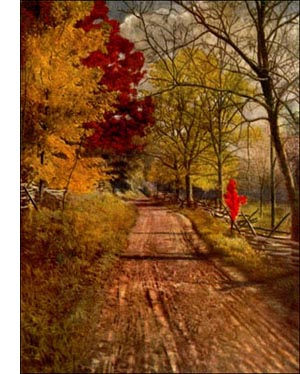Hop Hornbeam or Ironwood Hornbeam Tree
 Hop Hornbeam, Ironwood (Ostrya Virginiana, Small, slender tree, with round head of stiff, wiry branches, Bark greyish brown, furrowed into narrow, scaly ridges, which break into small, oblong plates_ Wood reddish brown, heavy, cross grained, tough, strong an(![ hard to work. Buds lateral, ovate, acute, small, brown. Leaves ovate, acuminate, sharply and doubly serrate, 3 to 5 inches, thin, tough, dull yellow-green above, paler beneath; yellow in autumn; petioles short, hairy. 'Flowers with leaves, April and May, monoecious; staminate in catkins formed previous season; pistillate erect, loose catkins, each flower surrounded by three united bracts. Fruit a hop-like cluster of inflated bags, formed of bracts, each containing a hard little seed. Pre erred habitat, shady forest ground. Distribution, Nova Scotia to Black Hills; south to Florida and Texas. Uses: Wood used for mallets, levers and tool handles. Desirable for ornamental planting. but rarely used.
Hop Hornbeam, Ironwood (Ostrya Virginiana, Small, slender tree, with round head of stiff, wiry branches, Bark greyish brown, furrowed into narrow, scaly ridges, which break into small, oblong plates_ Wood reddish brown, heavy, cross grained, tough, strong an(![ hard to work. Buds lateral, ovate, acute, small, brown. Leaves ovate, acuminate, sharply and doubly serrate, 3 to 5 inches, thin, tough, dull yellow-green above, paler beneath; yellow in autumn; petioles short, hairy. 'Flowers with leaves, April and May, monoecious; staminate in catkins formed previous season; pistillate erect, loose catkins, each flower surrounded by three united bracts. Fruit a hop-like cluster of inflated bags, formed of bracts, each containing a hard little seed. Pre erred habitat, shady forest ground. Distribution, Nova Scotia to Black Hills; south to Florida and Texas. Uses: Wood used for mallets, levers and tool handles. Desirable for ornamental planting. but rarely used.The hop hornbeam looks like a relative of the birches. Its leaves convey this impression, and slender limbs in winter bear green catkins that cluster in threes on the ends of twigs and wait for spring, just as the birch catkins do.
The bark of this hornbeam is thin and scales off in narrow strips whose surfaces are covered with squarish scales. The pale colour and the stripping of the bark reminds us of the shellbark-its shaggy strips reduced to a small scale. Among the branches the bark is smooth and close, and the twigs lock like fine wires, springing out at right angles from the stem.
In spring the staminate catkins swing out, even as the birch flowers do, but the pistillate clusters have to be looked for. The red, forked tongues thrust out for pollen may be seen at the ends of leafy side shoots. Here the midsummer shows a hop-like cluster of little pale green sacs, each with a shining seed inside.
The hop hornbeam is of a retiring disposition, preferring to hide in the shadows of taller trees. But there is nothing dark or funereal about it. The leaves, bright and green, are held out in level platforms where they can get the sunbeams that trickle down to them. .hen cones summer, and the pale green "hops" make the tree a centre that seems to shed light into dark places. The little hop tree, Ptelea trifoliata, is shining in its corner, and at a short distance the two trees might confused. Each one is a blessed sight on a hot day, for pale green against dark green is always a cool colour scheme.
in the late autunnn, after the leaves turn yellow and fall, the hops still hang, grudgingly giving tip one little seed balloon after another to the insistent wind. There is likely to be a long sail for each one, and perhaps more than one, for until the bag is punctured and the seed covered, the wind gives it no rest.
The wood of the hop hornbeam is vexatious stuff for the turner, and whoever else tries tool upon it. But once it takes shape it lasts indefinitely. Sled stakes, lovers, rake teeth, tool handles, wedges, do not soon need replacing if made of this material. It is equally satisfactory when used for fence posts.
The parks about Boston have beautiful specimens of the hop hornheam, showing that its merits as an ornamental tree are being recognised by the best judges. The next step will be its Increasing popularity for private grounds.